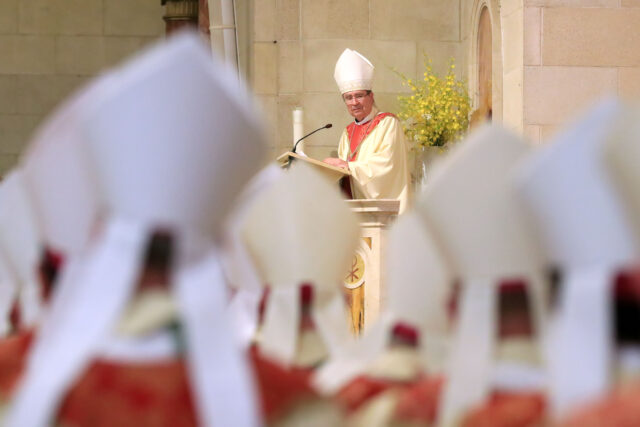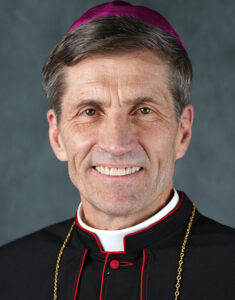
WILMINGTON — The Diocese of Wilmington witnessed a bit of history when Bishop William Koenig was ordained to the episcopate on July 13 at St. Elizabeth Church in Wilmington. For the first time in more than a century, a priest will become a bishop within the boundaries of the state of Delaware and the Eastern Shore of Maryland.
“It’s only the second time a bishop will be ordained in the territory of the diocese,” said Father Joseph McQuaide, the chancellor, said before the Mass.
The last time the diocese witnessed the ordination of its bishop was in 1897, when John J. Monaghan was elevated to the position at St. Peter Cathedral in Wilmington. Bishop Monaghan was a native of South Carolina who oversaw a growing diocese, opening seven new parishes, seven missions and eight schools during his 28 years as the ordinary. He was just 40 when became the bishop.
Bishop Monaghan, in fact, is the only man thus far who has been ordained to lead the diocese within its boundaries. The first two bishops were ordained in Baltimore and came to Wilmington within a week. Bishop Edmund FitzMaurice, who succeeded Bishop Monaghan, was ordained in Philadelphia. Since then, all of the diocese’s bishops were auxiliaries elsewhere, and Bishop Hubert Cartwright, who was appointed coadjutor of the diocese but died just a year and a half after arriving in Delaware, was made a bishop in Philadelphia just before coming to Wilmington.

There were some differences for Bishop Koenig’s arrival compared to those of recent prelates, Father McQuaide said. Priestly ordinations require just one bishop, he said, “but in order to ordain a bishop, you need at least three. And the reason for that is to make sure that at least one of them … is a real bishop who goes all the way back to the apostles.”
In the days when communication across distances wasn’t as reliable, he explained, people weren’t always sure that the men who showed up claiming to be bishops actually were.
Archbishop William E. Lori of Baltimore presided for the first part of the installation Mass. He was joined by Bishops W. Francis Malooly of Wilmington and John O. Barres of Bishop Koenig’s Diocese of Rockville Centre, N.Y.
After the gospel, the congregation sang a hymn praying for the Holy Spirit to come, after which the bishop was presented by one of the priests of Rockville Centre.
“Archbishop Lori will ask if we have the mandate of the Apostolic See. We can’t just decide to make a priest a bishop. It has to come from Rome. So before he continues, he has to make sure,” Father McQuaide said.
At that point, Archbishop Christophe Pierre, the papal nuncio to the United States, showed the papal bull — the official document from the Vatican — authorizing Bishop Koenig’s appointment. Archbishop Pierre made some remarks and handed the bull to Bishop Koenig. He showed it to the congregation, primarily to the diocesan college of consultors, a group of eight priests who advise the bishop.
Archbishop Lori asked the bishop to make certain promises, including to be a good shepherd in seeking out those who stray.
Bishop Koenig prostrated himself on the floor of St. Elizabeth as a sign of humility and dependence on God, and the congregation prayed a litany of the saints. All of the bishops present laid hands on him “as a sign of their sharing the office and the role of the episcopate with him. After all of them have laid on hands, Archbishop Lori will lead them in praying the prayer of ordination,” Father McQuaide said.
During that prayer, the Book of the Gospels was held open over Bishop Koenig’s head. After that, Father McQuaide said, he’s Bishop Koenig, “but we need to make him look the part.”
He knelt before Archbishop Lori and was anointed with chrism oil. His head was consecrated as a sign that he is leading the whole church. He was also given the Book of the Gospels. The archbishop presented him with a bishop’s ring “as a symbol that he is wed to the church,” Father McQuaide said.
Archbishop Lori then placed the miter on Bishop Koenig’s head. It has symbols on both sides. The last thing he received is his crosier “as a sign of his role as the shepherd who will watch over the entire flock that is the diocese,” Father McQuaide said.
All of the bishops exchanged the sign of peace with him, and he was led to the presider’s chair. The cathedra — or bishop’s chair — is at St. Peter Cathedral.
From that point forward, the new bishop took possession of the diocese, and he was incardinated into the Diocese of Wilmington. Mass continued at the point with Bishop Koenig as the principal celebrant.
“So he’s right to work,” Father McQuaide said.






